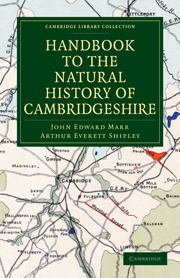Book contents
- Frontmatter
- PREFACE
- Contents
- ADDENDA AND CORRIGENDA
- PHYSIOGRAPHY
- GEOLOGY
- VERTEBRATE PALÆONTOLOGY
- ZOOLOGY
- Mammals
- Birds
- Reptiles and Amphibians
- Fishes
- Mollusca
- Insects: Introduction
- Insects: Orthoptera
- Insects: Neuroptera
- Insects: Hemiptera
- Insects: Coleoptera
- Insects: Lepidoptera
- Insects: Diptera
- Insects: Hymenoptera
- Myriapoda
- Arachnida
- Crustacea
- FLORA
- PREHISTORIC ARCHÆOLOGY
- Appendix to the Article on the Mollusca
- INDEX
- Plate section
Insects: Coleoptera
Published online by Cambridge University Press: 10 November 2010
- Frontmatter
- PREFACE
- Contents
- ADDENDA AND CORRIGENDA
- PHYSIOGRAPHY
- GEOLOGY
- VERTEBRATE PALÆONTOLOGY
- ZOOLOGY
- Mammals
- Birds
- Reptiles and Amphibians
- Fishes
- Mollusca
- Insects: Introduction
- Insects: Orthoptera
- Insects: Neuroptera
- Insects: Hemiptera
- Insects: Coleoptera
- Insects: Lepidoptera
- Insects: Diptera
- Insects: Hymenoptera
- Myriapoda
- Arachnida
- Crustacea
- FLORA
- PREHISTORIC ARCHÆOLOGY
- Appendix to the Article on the Mollusca
- INDEX
- Plate section
Summary
Cambridgeshire, to the general collector, is somewhat uninteresting, being but a moderate sized county, very flat, and considerably cultivated, but is of course redeemed by the Fens, which support many rare and local insects. These are the remnants of very much larger marshy areas, which formerly occupied the whole of the district, and the species that haunt them have naturally been driven and condensed into this smaller space, and, indeed, may be compared to Hereward the Wake, holding it as their last stronghold. Although one or two species, which will he dealt with later, seem to have disappeared before drainage, as in the case of the Great Copper in the Lepidoptera, the majority of the fen-dwellers still survive at Wicken and other localities, and some are now only found there in Britain. The following notes only deal with the more local and rare species, and those of the purely fen-insects.
To commence with the Geodephaga, or Ground-beetles, the rare variety consitus of Carabus monilis has been taken at Wicken, and Carabus granulatus is common in the fens on paths, and under cut herbage, etc. Wollaston records a dozen specimens of the local Calosoma inquisitor as being once taken by a gentleman at Gamlingay. Blethisa multipunctata, which occurs in marshy places, on the mud at the edges of pools and so on, is recorded from the Cambridgeshire Fens, as also the rare Elaphrus uliginosus.
- Type
- Chapter
- Information
- Handbook to the Natural History of Cambridgeshire , pp. 155 - 160Publisher: Cambridge University PressPrint publication year: 2010First published in: 1904

